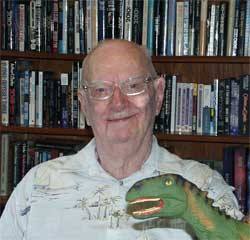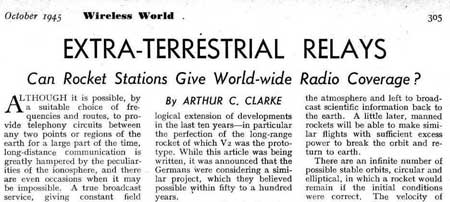|
Sixty years
after Arthur C. Clarke predicted communications satellites, what
lies inside the mind of the leading science fiction writer and science
guru?
by Heather Couper
The heat and humidity knock you for six the moment you step off
the plane. Then you hit downtown in a big way –it’s
heaving, tatty and gridlocked. Welcome to Colombo, Sri Lanka.
Ironically,
my mission in this earthy city is to track down a human being who,
more than any other, has his sights set firmly off this planet.
For Colombo is the home of science fiction writer and future-guru,
Sir Arthur C. Clarke.
Exactly 60 years ago,
Clarke published an article that changed the face of life on this
planet. In an era when there were no space launchers, no satellites,
and uncertain ideas about radio propagation, he predicted global
communications, weather satellites and even satellite television.

The
guru with a few of his books and his dinosaur phone
CREDIT: Paul
Parsons
|
Having alerted
the BBC to this anniversary, they have commissioned me to present
a programme on Radio 4 and on the World Service. I don’t sleep
well that night… and I’m nervous as our driver pulls
up outside ‘Leslie’s House’ (named after a Sri
Lankan friend of Clarke’s who died in a motorbike accident).
Arthur, in his adopted sarong, greets me in his book-lined study.
It’s more like a library: a celebration of the hundreds of
books and stories that Clarke has produced in his lifetime –
not to mention photographs of the author with virtually every great
person of the last few generations, plus awards, doctorates and
a Tyrannosaurus Rex which roars when the telephone rings. .
Arthur is now
87, and suffering from the after-effects of polio. But the legendary
Clarke sense of humour is still very much intact. I joke with him
about the Web. For someone who has pioneered global communications,
Arthur is notoriously Web-unfriendly. “Oh yes – The
World-Wide Wait”, he quips. “Have I told you about my
invention of the Spam-Bomb? It blows up your computer if you send
messages that the other guy doesn’t want. Stand back, your
computer is about to blow up – KABOOM!”
So – who
is this man who has shaped the way we live our lives today –
and whose futuristic predictions have turned out to be so uncannily
accurate?
Clarke
was born in Minehead, Somerset, in 1917, and spent his early years
on the family farm. He was always an investigative and adventurous
child. “Somewhere in me is a curiosity sensor”, he tells
me. “I want to know what’s over the next hill. You know,
people can live longer without food than without information. Without
information, you’d go crazy”.
But surely living in
the backwoods of the English countryside was hardly a fast-track
to space? “I guess I grabbed every book and article as soon
as it came out”, recalls Clarke. “So being in deepest
Somerset gave me time to think about these things”.
While his siblings were
enjoying life on the farm, Arthur was building telescopes and launching
home-made rockets. Did the other children join in their brother’s
activities? “No!” recalls his younger brother Fred with
a shudder. “We kept away from the dangerous blighter”.
In
1934, Arthur C. Clarke joined the newly-formed British Interplanetary
Society. “People then must have made fun of it”, says
Arthur. “I mean – British Interplanetary Society. Were
we going to make another Empire out there?”
After Clarke
moved to London, his flat became the centre of activities for the
growing number of ‘space cadets’, and he began to write
the Society’s journal – in addition to fictional pieces
for ‘fanzines’.
Then World War
II struck. Aircraftman Class 2 Arthur Charles Clarke found himself
working on a top secret, hi-tech project – the use of radar.
Arthur’s wartime experiences led directly to him writing his
prophetic 1945 paper in Wireless World. It was entitled Extraterrestrial
Relays, and it predicted communications satellites in an orbit where
they would stay above the same point on the Earth’s surface.
The paper went largely unnoticed at the time, but its contents were
noted with interest by organisations such as the US Navy Department.

Title
page of Clarke's historic paper 1945 paper in Wireless
World
|
Clarke pocketed the £15
cash payment and settled down to a post-war life of more financially
productive writing. Delighted with the success of his first non-fiction
book, Interplanetary Flight, Clarke turned to fiction – including
a stint as advisor to the comic strip ‘Dan Dare’ in
Eagle magazine. His favourite science fiction novel – the
mystical Childhood’s End (1953) – was groundbreaking:
a true work of literature in a genre that had largely concerned
itself with boys’ toys.
Arthur is driven by science,
almost to exclusion of everything else. I wonder whether this is
the reason why his marriage to Marilyn Torgenson failed in 1953
after a mere six months.
But Clarke undoubtedly
has his passions. One is table tennis; the other is scuba-diving.
In 1950, Arthur met Mike Wilson, a romantic adventurer with an obsession
for ‘skin diving’ (as it was called then). The pair
embarked on a scuba trip to the Great Barrier Reef in 1954, then
followed it up with a major dive in Ceylon (now Sri Lanka) in 1956.

Heather
Couper presents Arthur with British donations for tsunami
relief
CREDIT:
Martin Redfern
|
What got Clarke
into diving? “Entirely my interest in space travel. I realised
I could experience weightlessness”. Diving led Clarke into
deeper waters that he could have anticipated – like a dramatic
move out of London to Sri Lanka, with which he had totally fallen
in love. He founded a dive centre, and wrote a number of dive books,
illustrated with his own underwater photographs. The recent tragic
tsunami in Sri Lanka carried off a number of the dive centre boats,
though the west of the country came off relatively unscathed.
Clarke’s
fans were disappointed when he appeared to swap science fiction
for scuba diving in the mid-fifties. But they needn’t have
worried. Arthur was to return with a vengeance. He was about to
tackle the screenplay of 2001.
In 1964, film
director Stanley Kubrick had just put the finishing touches to his
epic movie Dr Strangelove. Then he came up with his latest idea
– “a film on ETs”. But who could advise him? Colleagues
said that there was only one choice – Clarke.
Kubrick’s
first reaction was: “Clarke? He’s a recluse –
a nut who lives in a tree in India”. But he was soon persuaded
otherwise. The relationship between Clarke and Kubrick was rewarding
but rocky, and the project was four years in the making. The special
effects were utterly groundbreaking, influencing movie moguls like
George Lucas and Steven Spielberg to go even further.
Would Clarke
himself like to go into space? “Of course – I’d
go like a shot. The Moon’s an obvious one. And Mars. Plus
the moons of Jupiter and Saturn – wonderful views and possibilities
of exotic lifeforms”.

Cracks
in the icy surface of Jupiter’s moon Europa are home
to aliens in Arthur’s novel 2010
|
2001 established
Clarke’s reputation and gave him millions of new fans. But
science-fiction writer Stephen Baxter believes that the influence
of 2001 goes further than that – it gives us an insight into
the mind of the man. “The fascinating thing about his fiction
is that it’s written with a both rational pole and a dreaming
pole. The dreaming pole is almost mystical, as in Childhood’s
End”.
“In the
screenplay of 2001,” Baxter continues, “Stanley Kubrick
effectively mapped Arthur’s mind. It’s how he juxtaposes
the immediate future of space technology with visions of the destiny
of mankind that are so powerful”.
Perhaps this
visionary aspect explains why Clarke has managed to court members
of the literary fraternity. He persuaded George Bernard Shaw to
become an active member of the BIS, and welcomed both the writer
J.B. Priestley and the archaeologist Jacquetta Hawkes to Sri Lanka.
Gore Vidal was also a visitor.
Stephen Baxter
is also quick to point out how valuable Clarke’s rational
side has been. “His influence on science has been very important.
He’s taken very seriously by the space community – I
think his skill is that he combines engineering with imagination”.
That combination
has led to Clarke’s reputation as a guru of the future. But
how do we determine the future? “New space technologies are
the way ahead,” he emphases. “Let me make an analogy:
ask an intelligent fish what new technologies it would find if it
crawled out of the sea to explore the land and air. I bet you it
wouldn’t have thought of fire”.
And finally,
I couldn’t leave Arthur C. Clarke without posing the ultimate
question: what will be the destiny of the human race? “I think
we’ve had hardwired into us this impulse to explore, to examine,
to play – and if we lose it, we’ll cease to be human.
The machines will take over, and it will serve us right!”
|
